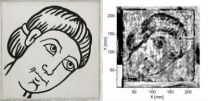(Press-News.org) It was a special moment for Michael Panzner of the Fraunhofer Institute for Material and Beam Technology IWS in Dresden, Germany and his partners: in the Dresden Hygiene Museum the scientists were examining a wall picture by Gerhard Richter that had been believed lost long ago. Shortly before leaving the German Democratic Republic the artist had left it behind as a journeyman's project. Then, in the 1960s, it was unceremoniously painted over. However, instead of being interested in the picture, Panzer was far more interested in the new detector which was being used for the first time here. Using it, the scientists gained important information about the layered structure of the wall and the structure of the picture area being examined. The joint project was sponsored by IWS, the Academy of Fine Arts Dresden [Hochschule für bildende Künste Dresden (HFBK)], the Research Institute for Monument Conservation and Archeometry [Forschungsinstitut für Denkmalpflege und Archäometrie (FIDA)] and the Technical University Dresden through the German Federal Ministry of Education and Research BMBF.
According to Panzer, the special thing about the terahertz (THz) scanner is that „In comparison with traditional processes, such as X-ray scanners, it works without causing any damage whatsoever. In addition, it does not require a special permit, as in the case of harmful X-rays. This is because the scanner only generates a radiated power of less than 1 µW. For comparison: under less than ideal conditions, cell phones emit up to 2 Watts. Furthermore the process, provides concrete data on the structure of the individual layers or of potential hollow areas. In this way the device also indicated in the Hygiene Museum that in one area the plaster on the wall had evidently been repaired - a valuable clue for the restorer.
The scientists used short electromagnetic pulses that penetrate the various materials almost without attenuation, whereby some materials display characteristic absorption lines, which can be used to identify them clearly. In previous tests, however, the system had reached its limits, for example with behind-the-wall paintings on uneven, very structured walls. For this reason the scientists at IWS continued to develop the detector head by modifying the THz optics together with the Fraunhofer Institute for Physical Measurement Techniques IPM. The application spectrum of the scanner was also expanded.
Caution, contaminated art
Currently, many museums cannot present valuable exhibits to the public because they are contaminated with biocides. The reason for this is that in the 1970s, with the best of intentions, antique textiles or wood sculptures were sprayed with pesticides to keep them from being destroyed. Today it is known that these agents are hazardous to health and a number of different measurement and decontamination processes are being tested. IWS, together with further partners, now wants to set up a project with the aim examining the possibilities and limits of the THz technology for organic biocides. „In contrast to the current X-ray fluorescence analysis which works on an element-selective basis, THz scanners recognize substances on the basis of the molecular bonding structure. Organic biocides, in particular, could be differentiated in such a manner," explains Michael Panzner.
To date, such expensive examinations are often only possible in well-equipped laboratories. In the future the tests are to be feasible on-site using a mobile scanner. However, a more research is still required until small, portable devices are available that are suitable for such purposes. Above all, close communication and cooperation with restorers and monument preservationists is required for the continued technological improvement of the THz measurement system. Panzner and his team are also hoping for a lively exchange at the European trade fair for monument preservation, restoration and refurbishment of old buildings, the denkmal, in Leipzig, Germany, where they will be exhibiting the new THz scanner generation in Hall 2, stand H30, from November 22 - 24, 2012.
INFORMATION:
Detective work using terahertz radiation
2012-11-21
ELSE PRESS RELEASES FROM THIS DATE:
Architecture of rod sensory cilium disrupted by mutation
2012-11-21
HOUSTON – (Nov. 22, 2012) – Using a new technique called cryo-electron tomography, two research teams at Baylor College of Medicine (www.bcm.edu) have created a three-dimensional map that gives a better understanding of how the architecture of the rod sensory cilium (part of one type of photoreceptor in the eye) is changed by genetic mutation and how that affects its ability to transport proteins as part of the light-sensing process.
Almost all mammalian cells have cilia. Some are motile and some are not. They play a central role in cellular operations, and when they ...
New evidence of dinosaurs' role in the evolution of bird flight
2012-11-21
Academics at the Universities of Bristol, Yale and Calgary have shown that prehistoric birds had a much more primitive version of the wings we see today, with rigid layers of feathers acting as simple airfoils for gliding.
Close examination of the earliest theropod dinosaurs suggests that feathers were initially developed for insulation, arranged in multiple layers to preserve heat, before their shape evolved for display and camouflage.
As evolution changed the configuration of the feathers, their important role in the aerodynamics and mechanics of flight became more ...
New Informatics and Bioimaging Center combines resources, expertise from UMD, UMB
2012-11-21
ADELPHI, Md. – A new center that combines advanced computing resources at the University of Maryland, College Park (UMD) with clinical data and biomedical expertise at the University of Maryland, Baltimore (UMB) could soon revolutionize the efficiency and effectiveness of health care in the state of Maryland and beyond.
The Center for Health-related Informatics and Bioimaging (CHIB) announced today joins computer scientists, life scientists, engineers, physicists, biostatisticians and others at the College Park campus with imaging specialists, physicians, clinicians ...
Wormholes from centuries-old art prints reveal the history of the 'worms'
2012-11-21
By examining art printed from woodblocks spanning five centuries, Blair Hedges, a professor of biology at Penn State University, has identified the species responsible for making the ever-present wormholes in European printed art since the Renaissance. The hole-makers, two species of wood-boring beetles, are widely distributed today, but the "wormhole record," as Hedges calls it, reveals a different pattern in the past, where the two species met along a zone across central Europe like a battle line of two armies. The research, which is the first of its kind to use printed ...
Human obedience: The myth of blind conformity
2012-11-21
In the 1960s and 1970s, classic social psychological studies were conducted that provided evidence that even normal, decent people can engage in acts of extreme cruelty when instructed to do so by others. However, in an essay published November 20 in the open access journal PLOS Biology, Professors Alex Haslam and Stephen Reicher revisit these studies' conclusions and explain how awful acts involve not just obedience, but enthusiasm too—challenging the long-held belief that human beings are 'programmed' for conformity.
This belief can be traced back to two landmark empirical ...
Beneficial microbes are 'selected and nurtured' in the human gut
2012-11-21
Animals, including humans, actively select the gut microbes that are the best partners and nurture them with nutritious secretions, suggests a new study led by Oxford University, and published November 20 in the open-access journal PLOS Biology.
The Oxford team created an evolutionary computer model of interactions between gut microbes and the lining (the host epithelial cell layer) of the animal gut. The model shows that beneficial microbes that are slow-growing are rapidly lost, and need to be helped by host secretions, such as specific nutrients, that favour the beneficial ...
The evolution of human intellect: Human-specific regulation of neuronal genes
2012-11-21
A new study published November 20 in the open-access journal PLOS Biology has identified hundreds of small regions of the genome that appear to be uniquely regulated in human neurons. These regulatory differences distinguish us from other primates, including monkeys and apes, and as neurons are at the core of our unique cognitive abilities, these features may ultimately hold the key to our intellectual prowess (and also to our potential vulnerability to a wide range of 'human-specific' diseases from autism to Alzheimer's).
Exploring which features in the genome separate ...
Study finds link between access to online health information and use of clinical services
2012-11-21
DENVER, Nov. 20 — Patients with online access to their medical record, including secure email communication with clinicians, had an associated increase in use of some clinical services, according to new Kaiser Permanente research published this month in the Journal of the American Medical Association.
The study examined health records of more than 500,000 Kaiser Permanente members in Colorado between May 2005 and June 2010. The researchers looked at office visits, telephone encounters, after-hours clinic visits, emergency department encounters, and hospitalizations ...
Patients with online access to clinicians, medical records have increased use of clinical services
2012-11-21
CHICAGO – Patients with online access to their medical records and secure e-mail communication with clinicians had increased use of clinical services, including office visits and telephone encounters, compared to patients who did not have online access, according to a study appearing in the November 21 issue of JAMA.
"Using health information technology to foster efficient health care delivery is an important component of health care reform," according to background information in the article. "Prior studies suggest that providing patients with online access to health ...
Citicoline does not improve functional, cognitive status in patients with traumatic brain injury
2012-11-21
CHICAGO – Although approved for use for treating traumatic brain injury (TBI) in nearly 60 countries, use of citicoline in a randomized trial that included more than 1,200 participants with TBI did not result in improvement in functional and cognitive status, according to a study appearing in the November 21 issue of JAMA.
"Despite considerable advances in emergency and critical care management of TBI as well as decades of research on potential agents for neuroprotection or enhanced recovery, no effective pharmacotherapy has yet been identified," according to background ...

